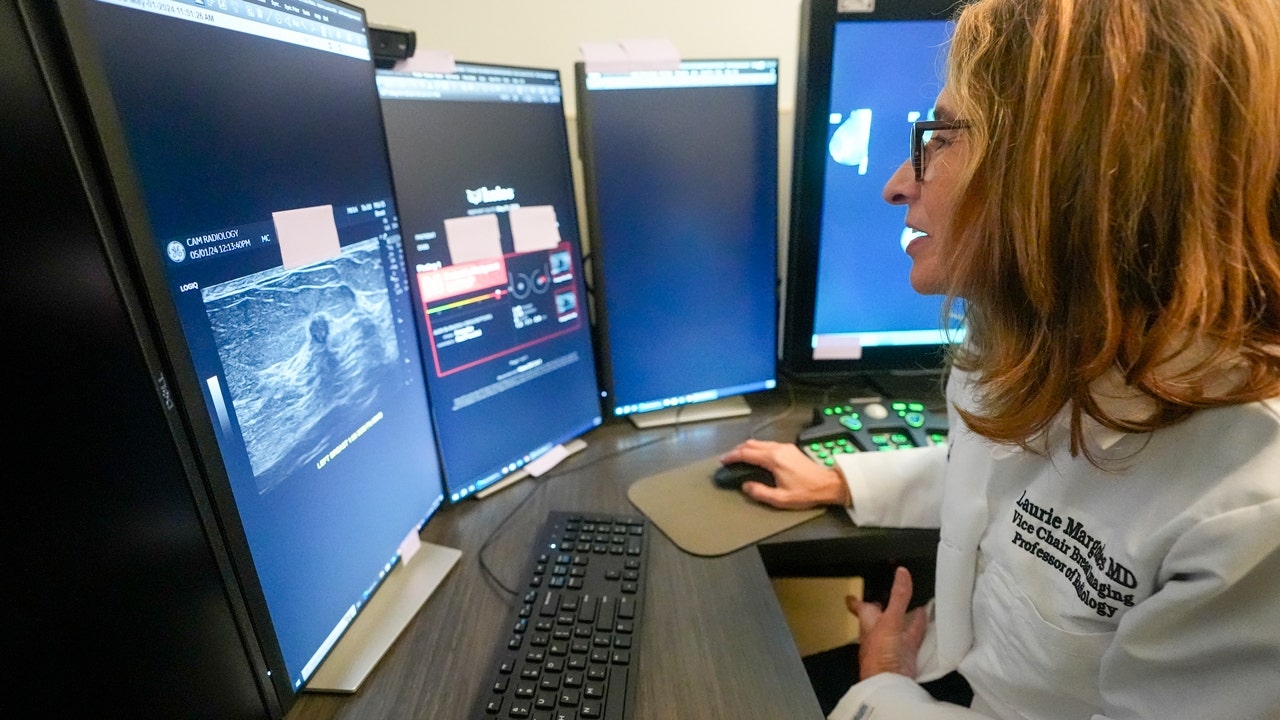On Monday, it initially seemed like the beginning of the end for Intel’s desktop CPU instability woes — the company confirmed a patch is coming in mid-August that should address the “root cause” of exposure to elevated voltage. But if your 13th or 14th Gen Intel Core processor is already crashing, that patch apparently won’t fix it.
Technology
AI is permeating American culture, but radiologists hesitant to place patients' health in an algorithm's hands

How good would an algorithm have to be to take over your job?
It’s a new question for many workers amid the rise of ChatGPT and other AI programs that can hold conversations, write stories and even generate songs and images within seconds.
For doctors who review scans to spot cancer and other diseases, however, AI has loomed for about a decade as more algorithms promise to improve accuracy, speed up work and, in some cases, take over entire parts of the job. Predictions have ranged from doomsday scenarios in which AI fully replaces radiologists, to sunny futures in which it frees them to focus on the most rewarding aspects of their work.
AI TECH AIMS TO DETECT BREAST CANCER BY MIMICKING RADIOLOGISTS’ EYE MOVEMENTS: ‘A CRITICAL FRIEND’
That tension reflects how AI is rolling out across health care. Beyond the technology itself, much depends upon the willingness of doctors to put their trust — and their patients’ health — in the hands of increasingly sophisticated algorithms that few understand.
Even within the field, opinions differ on how much radiologists should be embracing the technology.
“Some of the AI techniques are so good, frankly, I think we should be doing them now,” said Dr. Ronald Summers, a radiologist and AI researcher at the National Institutes of Health. “Why are we letting that information just sit on the table?”
Dr. Laurie Margolies demonstrates the Koios DS Smart Ultrasound software, Wednesday, May 8, 2024, at Mount Sinai hospital in New York. The breast imaging AI is used to get a second opinion on mammography ultrasounds. “I will tell patients, ‘I looked at it, and the computer looked at it, and we both agree,’” Margolies said. “Hearing me say that we both agree, I think that gives the patient an even greater level of confidence.” (AP Photo/Mary Altaffer)
Summers’ lab has developed computer-aided imaging programs that detect colon cancer, osteoporosis, diabetes and other conditions. None of those have been widely adopted, which he attributes to the “culture of medicine,” among other factors.
Radiologists have used computers to enhance images and flag suspicious areas since the 1990s. But the latest AI programs can go much further, interpreting the scans, offering a diagnosis and even drafting written reports about their findings. The algorithms are often trained on millions of X-rays and other images collected from hospitals and clinics.
Across medicine, the FDA has OK’d more than 700 AI algorithms to aid physicians. More than 75% of them are in radiology, yet just 2% of radiology practices use such technology, according to one recent estimate.
For all the promises from industry, radiologists see a number of reasons to be skeptical of AI programs: limited testing in real-world settings, lack of transparency about how they work and questions about the demographics of the patients used to train them.
ARTIFICIAL INTELLIGENCE NOT ALWAYS HELPFUL FOR REDUCING DOCTOR BURNOUT, STUDIES SUGGEST
“If we don’t know on what cases the AI was tested, or whether those cases are similar to the kinds of patients we see in our practice, there’s just a question in everyone’s mind as to whether these are going to work for us,” said Dr. Curtis Langlotz, a radiologist who runs an AI research center at Stanford University.
To date, all the programs cleared by the FDA require a human to be in the loop.
In early 2020, the FDA held a two-day workshop to discuss algorithms that could operate without human oversight. Shortly afterwards, radiology professionals warned regulators in a letter that they “strongly believe it is premature for the FDA to consider approval or clearance” of such systems.
But European regulators in 2022 approved the first fully automatic software that reviews and writes reports for chest X-rays that look healthy and normal. The company behind the app, Oxipit, is submitting its U.S. application to the FDA.
The need for such technology in Europe is urgent, with some hospitals facing monthslong backlogs of scans due to a shortage of radiologists.
In the U.S., that kind of automated screening is likely years away. Not because the technology isn’t ready, according to AI executives, but because radiologists aren’t yet comfortable turning over even routine tasks to algorithms.
“We try to tell them they’re overtreating people and they’re wasting a ton of time and resources,” said Chad McClennan, CEO of Koios Medical, which sells an AI tool for ultrasounds of the thyroid, the vast majority of which are not cancerous. “We tell them, ‘Let the machine look at it, you sign the report and be done with it.’”
Radiologists tend to overestimate their own accuracy, McClennan says. Research by his company found physicians viewing the same breast scans disagreed with each other more than 30% of the time on whether to do a biopsy. The same radiologists even disagreed with their own initial assessments 20% of the time, when viewing the same images a month later.
About 20% of breast cancers are missed during routine mammograms, according to the National Cancer Institute.
And then there’s the potential for cost savings. On average, U.S. radiologists earn over $350,000 annually, according to the Department of Labor.
In the near term, experts say AI will work like autopilot systems on planes — performing important navigation functions, but always under the supervision of a human pilot.
That approach offers reassurances to both radiologists and patients, says Dr. Laurie Margolies, of Mount Sinai hospital system in New York. The system uses Koios breast imaging AI to get a second opinion on mammography ultrasounds.
“I will tell patients, ‘I looked at it, and the computer looked at it, and we both agree,’” Margolies said. “Hearing me say that we both agree, I think that gives the patient an even greater level of confidence.”
The first large, rigorous trials testing AI-assisted radiologists against those working alone give hints at the potential improvements.
Initial results from a Swedish study of 80,000 women showed a single radiologist working with AI detected 20% more cancers among mammograms than two radiologists working without the technology.
In Europe, mammograms are reviewed by two radiologists to improve accuracy. But Sweden, like other countries, faces a workforce shortage, with only about 70 breast radiologists in a country of 10 million people.
Using AI instead of a second reviewer decreased the human workload by 44%, according to the study.
Still, the study’s lead author says it’s essential that a radiologist make the final diagnosis in all cases.
If an automated algorithm misses a cancer, “that’s going to be very negative for trust in the caregiver,” said Dr. Kristina Lang of Lund University.
The question of who would be held liable in such cases is among the thorny legal issues that have yet to be resolved.
One result is that radiologists are likely to continue double-checking all AI determinations, lest they be held responsible for an error. That’s likely to wipe out many of the predicted benefits, including reduced workload and burnout.
Only an extremely accurate, reliable algorithm would allow radiologists to truly step away from the process, says Dr. Saurabh Jha of the University of Pennsylvania.
Until such systems emerge, Jha likens AI-assisted radiology to someone who offers to help you drive by looking over your shoulder and constantly pointing out everything on the road.
“That’s not helpful,” Jha says. “If you want to help me drive then you take over the driving so that I can sit back and relax.”

Technology
Here’s your first look at Amazon’s Like a Dragon: Yakuza
/cdn.vox-cdn.com/uploads/chorus_asset/file/25547838/YAKZA_3840_2160_A_Elogo.jpg)
Amazon says that the show “showcases modern Japan and the dramatic stories of these intense characters, such as the legendary Kazuma Kiryu, that games in the past have not been able to explore.” Kiryu will be played by Ryoma Takeuchi, while Kento Kaku also starts as Akira Nishikiyama. The series is directed by Masaharu Take.
Like a Dragon: Yakuza starts streaming on Prime Video on October 24th with its first three episodes.
Technology
Exciting AI tools and games you can try for free

I’m not an artist. My brain just does not work that way. I tried to learn Photoshop but gave up. Now, I create fun images using AI.
You need a vacation. We’re giving away a $1,000 getaway gift card for your favorite airline. Enter to win now!
Some AI tech is kind of freaky (like this brain-powered robot), but many of the new AI tools out there are just plain fun. Let’s jump into the wide world of freebies that will help you make something cool.
20 TECH TRICKS TO MAKE LIFE BETTER, SAFER OR EASIER
Create custom music tracks
Not everyone is musically inclined, but AI makes it pretty easy to pretend you are. At the very least, you can make a funny tune for a loved one who needs some cheering up.
AI to try: Udio
Perfect for: Experimenting with song styles
Starter prompt: “Heartbreak at the movie theater, ‘80s ballad”
Cheerful man sitting in front of his computer monitor eating and working. (iStock)
Just give Udio a topic for a song and a genre, and it’ll do the rest. I asked it to write a yacht rock song about a guy who loves sunsets, and it came up with two one-minute clips that were surprisingly good. You can customize the lyrics, too.
Produce quick video clips
The built-in software on our phones does a decent job at editing down the videos we shoot (like you and the family at the beach), but have you ever wished you could make something a little snazzier?
AI to try: Invideo
Perfect for: Quick content creation
TIME-SAVING TRICKS USING YOUR KEYBOARD
Starter prompt: “Cats on a train”
Head to Invideo to produce your very own videos, no experience needed. Your text prompts can be simple, but you’ll get better results if you include more detail.
You can add an AI narration over the top (David Attenborough’s AI voice is just too good). FYI, the free account puts a watermark on your videos, but if you’re just doing it for fun, no biggie.
Draft digital artwork
You don’t need to be an AI whiz skilled at a paid program like Midjourney to make digital art. Here’s an option anyone can try.

Closeup shot of an unrecognizable woman using a laptop while working from home. (iStock)
AI to try: OpenArt
Perfect for: Illustrations and animations
Starter prompt: “A lush meadow with blue skies”
OpenArt starts you off with a simple text prompt, but you can tweak it in all kinds of funky ways, from the image style to the output size. You can also upload images of your own for the AI to take its cues from and even include pictures of yourself (or friends and family) in the art.
If you’ve caught the AI creative bug and want more of the same, try the OpenArt Sketch to Image generator. It turns your original drawings into full pieces of digital art.
YOUR BANK WANTS YOUR VOICE. JUST SAY NO.
More free AI fun
Maybe creating videos and works of art isn’t your thing. There’s still lots of fun to be had with AI.
- Good time for kids and adults: Google’s Quick, Draw! Try to get the AI to recognize your scribblings before time runs out in this next-gen Pictionary-style game.
- Expose your kid to different languages: Another option from Google, Thing Translator, lets you snap a photo of something to hear the word for it in a different language. Neat!
- Warm up your vocal chords: Freddimeter uses AI to rate how well you can sing like Freddie Mercury. Options include “Don’t Stop Me Now,” “We Are the Champions,” “Bohemian Rhapsody” and “Somebody To Love.”

A mother uses a laptop while a little boy uses a tablet. (iStock)
If you’re not tech-ahead, you’re tech-behind
Award-winning host Kim Komando is your secret weapon for navigating tech.
Copyright 2024, WestStar Multimedia Entertainment. All rights reserved.
Technology
There is no fix for Intel’s crashing 13th and 14th Gen CPUs — any damage is permanent
/cdn.vox-cdn.com/uploads/chorus_asset/file/25546355/intel_13900k_tomwarren__2_.jpg)
Citing unnamed sources, Tom’s Hardware reports that any degradation of the processor is irreversible, and an Intel spokesperson did not deny that when we asked. Intel is “confident” the patch will keep it from happening in the first place. (As another preventative measure, you should update your BIOS ASAP.) But if your defective CPU has been damaged, your best option is to replace it instead of tweaking BIOS settings to try and alleviate the problems.
And, Intel confirms, too-high voltages aren’t the only reason some of these chips are failing. Intel spokesperson Thomas Hannaford confirms it’s a primary cause, but the company is still investigating. Intel community manager Lex Hoyos also revealed some instability reports can be traced back to an oxidization manufacturing issue that was fixed at an unspecified date last year.
This raises lots of questions. Will Intel recall these chips? Extend their warranty? Replace them no questions asked? Pause sales like AMD just did with its Ryzen 9000? Identify faulty batches with the manufacturing defect?
We asked Intel these questions, and I’m not sure you’re going to like the answers.
Why are these still on sale without so much as an extended warranty?
Intel has not halted sales or clawed back any inventory. It will not do a recall, period. The company is not currently commenting on whether or how it might extend its warranty. It would not share estimates with The Verge of how many chips are likely to be irreversibly impacted, and it did not explain why it’s continuing to sell these chips ahead of any fix.
Intel’s not yet telling us how warranty replacements will work beyond trying customer support again if you’ve previously been rejected. It did not explain how it will contact customers with these chips to warn them about the issue.
But Intel does tell us it’s “confident” that you don’t need to worry about invisible degradation. If you’re not currently experiencing issues, the patch “will be an effective preventative solution for processors already in service.” (If you don’t know if you’re experiencing issues, Intel currently suggests the Robeytech test.)
And, perhaps for the first time, Intel has confirmed just how broad this issue could possibly be. The elevated voltages could potentially affect any 13th or 14th Gen desktop processor that consumes 65W or more power, not just the highest i9-series chips that initially seemed to be experiencing the issue.
Here are the questions we asked Intel and the answers we’ve received by email from Intel’s Hannaford:
How many chips does Intel estimate are likely to be irreversibly impacted by these issues?
Intel Core 13th and 14th Generation desktop processors with 65W or higher base power – including K/KF/KS and 65W non-K variants – could be affected by the elevated voltages issue. However, this does not mean that all processors listed are (or will be) impacted by the elevated voltages issue.
Intel continues validation to ensure that scenarios of instability reported to Intel regarding its Core 13th and 14th Gen desktop processors are addressed.
For customers who are or have been experiencing instability symptoms on their 13th and/or 14th Gen desktop processors, Intel continues advising them to reach out to Intel Customer Support for further assistance. Additionally, if customers have experienced these instability symptoms on their 13th and/or 14th Gen desktop processors but had RMA [return merchandise authorization] requests rejected we ask that they reach out to Intel Customer Support for further assistance and remediation.
Will Intel issue a recall?
Will Intel proactively warn buyers of these chips about the warning signs or that this update is required? If so, how will it warn them?
Intel targets to release a production microcode update to OEM/ODM customers by mid-August or sooner and will share additional details on the microcode patch at that time.
Intel is investigating options to easily identify affected processors on end user systems. In the interim, as a general best practice Intel recommends that users adhere to Intel Default Settings on their desktop processors, along with ensuring their BIOS is up to date.
Has Intel halted sales and / or performed any channel inventory recalls while it validates the update?
Does Intel anticipate the fix will be effective for chips that have already been in service but are not yet experiencing symptoms (i.e., invisible degradation)? Are those CPUs just living on borrowed time?
Intel is confident that the microcode patch will be an effective preventative solution for processors already in service, though validation continues to ensure that scenarios of instability reported to Intel regarding its Core 13th/14th Gen desktop processors are addressed.
Intel is investigating options to easily identify affected or at-risk processors on end user systems.
It is possible the patch will provide some instability improvements to currently impacted processors; however customers experiencing instability on their 13th or 14th Generation desktop processor-based systems should contact Intel customer support for further assistance.
Will Intel extend its warranty on these 13th Gen and 14th Gen parts, and for how long?
Given how difficult this issue was for Intel to pin down, what proof will customers need to share to obtain an RMA? (How lenient will Intel be?)
What will Intel do for 13th Gen buyers after supply of 13th Gen parts runs out? Final shipments were set to end last month, I’m reading.
Intel is committed to making sure all customers who have or are currently experiencing instability symptoms on their 13th and/or 14th Gen desktop processors are supported in the exchange process. This includes working with Intel’s retail and channel customers to ensure end users are taken care of regarding instability symptoms with their Intel Core 13th and/or 14th Gen desktop processors.
What will Intel do for 14th Gen buyers after supply of 14th Gen parts run out?
Will replacement / RMA’d chips ship with the microcode update preapplied beginning in August? Is Intel still shipping replacement chips ahead of that update?
Intel will be applying to microcode to 13th/14th Gen desktop processors that are not yet shipped once the production patch is released to OEM/ODM partners (targeting mid-August or sooner). For 13th /14th Gen desktop processors already in service, users will need to apply the patch via BIOS update once available.
What, if anything, can customers do to slow or stop degradation ahead of the microcode update?
Intel recommends that users adhere to Intel Default Settings on their desktop processors, along with ensuring their BIOS is up to date. Once the microcode patch is released to Intel partners, we advise users check for the relevant BIOS updates.
Will Intel share specific manufacturing dates and serial number ranges for the oxidized processors so mission-critical businesses can selectively rip and replace?
Intel will continue working with its customers on Via Oxidation-related reports and ensure that they are fully supported in the exchange process.
Why does Intel believe the instability issues do not affect mobile laptop chips?
Intel is continuing its investigation to ensure that reported instability scenarios on Intel Core 13th/14th Gen processors are properly addressed.
This includes ongoing analysis to confirm the primary factors preventing 13th / 14th Gen mobile processor exposure to the same instability issue as the 13th/14th Gen desktop processors.
That’s all we’ve heard from Intel so far, though Hannaford assured us more answers are on the way and that the company is working on remedies.
Again, if your CPU is already damaged, you need to get Intel to replace it, and if Intel won’t do so, please let us know. In the meanwhile, you’ll want to update your BIOS as soon as possible because your processor could potentially be invisibly damaging itself — and if you know your way around a BIOS, you may want to adjust your motherboard to Intel’s default performance profiles, too.
Lastly, here is that Robeytech video that Intel is recommending to Redditors to potentially help them identify if their chip has an issue. Intel says it’s looking into other ways to identify that, too.
-

 World1 week ago
World1 week agoOne dead after car crashes into restaurant in Paris
-

 Midwest1 week ago
Midwest1 week agoMichigan rep posts video response to Stephen Colbert's joke about his RNC speech: 'Touché'
-

 News1 week ago
News1 week agoVideo: Young Republicans on Why Their Party Isn’t Reaching Gen Z (And What They Can Do About It)
-

 Movie Reviews1 week ago
Movie Reviews1 week agoMovie Review: A new generation drives into the storm in rousing ‘Twisters’
-

 News1 week ago
News1 week agoIn Milwaukee, Black Voters Struggle to Find a Home With Either Party
-

 Politics1 week ago
Politics1 week agoFox News Politics: The Call is Coming from Inside the House
-

 News1 week ago
News1 week agoVideo: J.D. Vance Accepts Vice-Presidential Nomination
-

 World1 week ago
World1 week agoTrump to take RNC stage for first speech since assassination attempt















